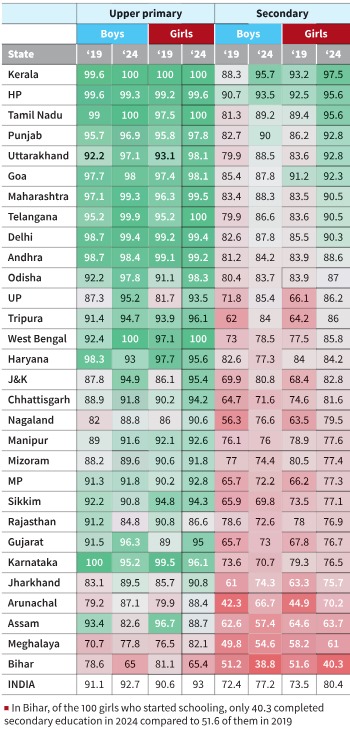The issue of school dropout rates continues to pose challenges in India, despite national improvements in retention rates at the secondary level. While the overall trend shows progress, with more students completing their education, certain states exhibit alarming trends that warrant closer examination.
National Trends in Retention
Between 2019 and 2024, there was a significant improvement in the share of students completing their secondary education. Among girls, the percentage rose from 73.5% in 2019 to 80% in 2024. Boys showed a less pronounced increase, from 72.4% to 77.2%. This reflects a positive shift in education outcomes at the national level.

States with Alarming Trends
Bihar and Assam: Worsening Dropout Rates
In Bihar and Assam, where dropout rates were already a concern in 2019, the situation deteriorated further in 2024.
- Bihar:
- Girls completing secondary education dropped from 51.6% in 2019 to 40.3% in 2024.
- Boys completing secondary education fell from 51.2% to 38.8%.
- Assam:
- Girls completing secondary education dropped from 54.2% in 2019 to 46.5% in 2024.
- Boys completing secondary education fell from 53.8% to 45.9%.
Rajasthan: Concerning Trends
Rajasthan has also seen a decline in retention rates, signaling a growing challenge in ensuring secondary education completion.
- Rajasthan:
- Girls completing secondary education dropped from 68.4% in 2019 to 62.7% in 2024.
- Boys completing secondary education fell from 66.5% to 60.9%.
Karnataka: Declining Trends
Karnataka has witnessed a similar pattern, with retention rates slipping over the years.
- Karnataka:
- Girls: Retention dropped from 79.3% (2019) to 76.5% (2024).
- Boys: Retention dropped from 73.6% to 70.7%.
Success Stories
Kerala and Tamil Nadu: Exemplary Progress
These states have not only maintained their strong performance but also improved further.
- Kerala:
- Boys completing secondary education rose from 88.3% (2019) to 95.7% (2024).
- Girls saw an improvement from 93.2% to 97.5%.
- Tamil Nadu:
- Boys completing secondary education improved from 81.3% (2019) to 89.2% (2024).
- Girls improved from 89.4% to 95.6%.
Mixed Performance: Maharashtra and Uttarakhand
Maharashtra
Maharashtra demonstrated moderate improvement in secondary education retention rates, although its degree of progress was outpaced by states like Uttarakhand.
- Girls completing secondary education rose from 83.5% in 2019 to 90.5% in 2024.
- Boys completing secondary education increased from 81.2% to 87.8%.
Uttarakhand
Uttarakhand showed remarkable progress, with one of the steepest improvements in secondary education retention rates.
- Girls completing secondary education improved from 83.5% in 2019 to 92.8% in 2024.
- Boys completing secondary education increased from 79.8% to 89.4%.
This significant improvement resulted in a substantial rise in Uttarakhand’s state rankings, showcasing the effectiveness of targeted educational policies.
State Rankings and Trends
An analysis of the degree of improvement or decline provides further insights:
- Uttarakhand: Demonstrated significant improvement, with its ranking for secondary school girls rising from 11th in 2019 to 4th in 2024.
- Maharashtra: Improved its ranking for girls but lagged behind Uttarakhand in the degree of improvement.
Gujarat and Haryana: Stagnation and Decline
- Gujarat remained at the bottom of the rankings for both years, showing no significant improvement.
- Haryana, which ranked among the top 10 states in 2019, witnessed a sharp decline in rankings across all levels of schooling by 2024.
Key Takeaways
- Policy Success in Kerala, Tamil Nadu, and Uttarakhand: Strong education policies and effective implementation have translated into exemplary retention rates.
- Challenges in Bihar, Assam, and Rajasthan: Focused interventions are required to address systemic issues contributing to worsening dropout rates.
- Need for Targeted Strategies: States like Karnataka and Maharashtra, showing slower improvement, need proactive measures to accelerate progress.
- Monitoring and Ranking: State rankings based on retention rates can serve as benchmarks to encourage competition and identify best practices.
Way Forward
Policymakers must analyze state-specific challenges and successes to formulate targeted interventions. States with declining trends should focus on improving infrastructure, addressing socio-economic barriers, and strengthening mid-day meal and scholarship programs to ensure students, especially girls, stay in school.
Also Read: Rural Poverty Declines to 4.86% in FY24: SBI Report
Disclaimer: The information provided is for educational purposes and general awareness, particularly for UPSC aspirants.
Follow Fusion IAS